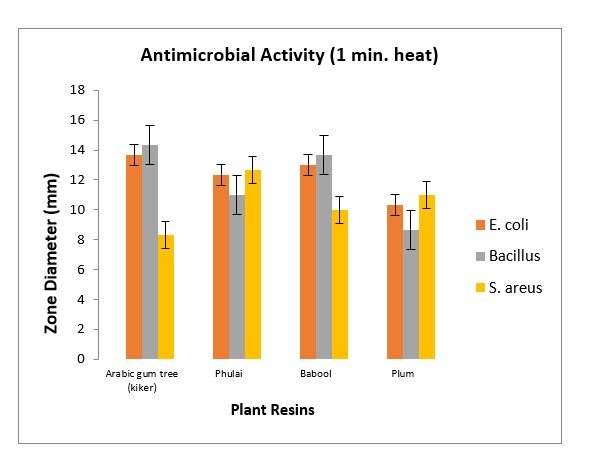Metabolomic Profiling and Bioactivity Evaluation of Plant Resins
Keywords:
Acacia nilotica, Acacia modestica, PhytochemicalsAbstract
The present study conducted to evaluate the phytochemical and antimicrobial potential of local plants resins including Kiker (Acacianilotica), Phulai (Acacia modesta), Gond babool (Acacia arabicae) and Aloo bukhara (Prunus domestica) collected from Haripur district. Ten-gram powder of the sample is mixed with 50 mL of 70% methanol and extracted by using ultrsonicator for 30 minutes. The mixture was filtered and concentrated in rotary evaporator till 2 mL remained. Samples were diluted with methanol (70%) and were analyzed in triplicates. The results indicated that phenolic compounds increases by heating as compared to raw resins extract. Aloo bukhara resin showed higher amount 8.33 mg/g while Gond babool have 7.21 mg/g, Phulai have 5.73 mg/g and Kiker have 4.61 mg/g total phenolics respectively. Total flavonoid content decreases in microwave heating. Resin extracts have higher radical scavenging activity when it is not heated. Kiker have highest radical scavenging activity i. e. 80% while Phulai have 69.99%, Gond babool have 74% and Plum have 75%. Moreover, heating results is decreased in antioxidant activity with the time difference. In microwave heating, Gond babool showed higher activity i. e. 73% for 1 min., 71% for 2 min. and 57% for 3 min. as compared to other resins. Antimicrobial activity results showed that Kiker resin have the greater zone diameter against E. coli and S. areus as compared to rest of varieties. Heat treatments increased the activity in Phulai and Aloo bukhara resins while decreased in Babool resin against different bacterial isolates. All the selected resins have a good amount of phytochemicals as well as antimicrobial activity. Industries uses these plant resin extract as antioxidant and antimicrobial in many food and other products because of a natural source and easy availability having health beneficial attributes as well as for their potential to improve product structure as a gum base.


















